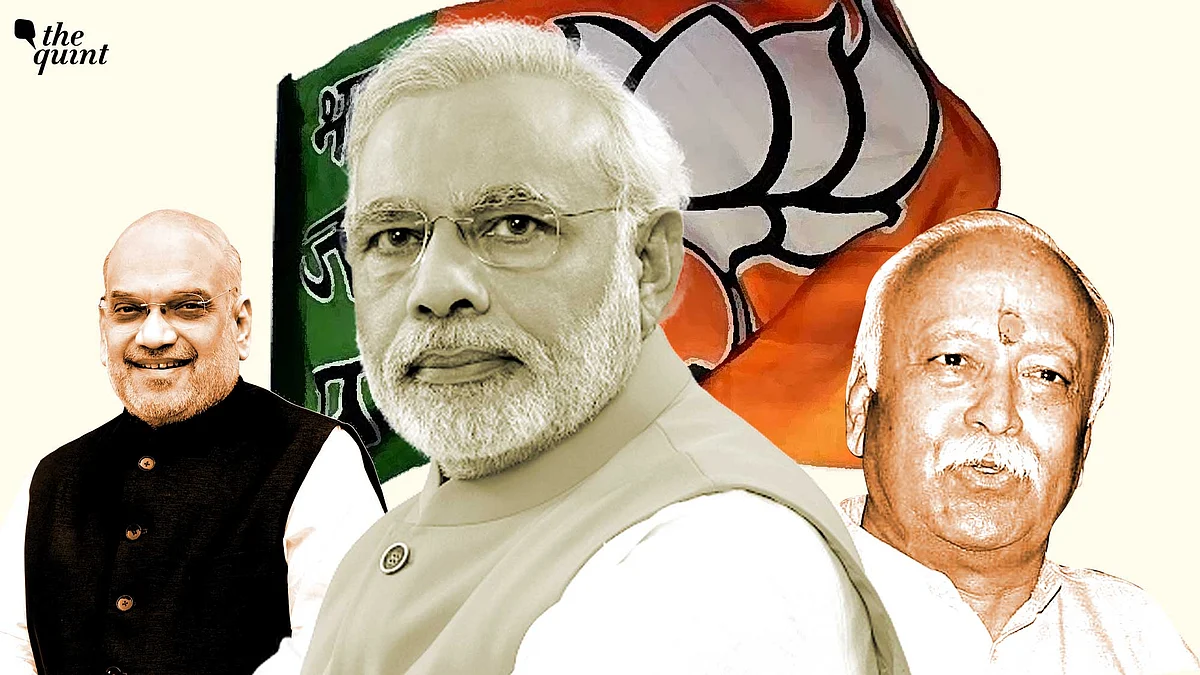
BJP's Next President May Decide 'Who After Modi?'
The BJP is set to 'elect' its new chief but the final decision rests with PM Modi and the RSS, writes Manish Anand.

advertisement
The Bharatiya Janata Party (BJP) will choose its next president in the coming three weeks.
The party's state units are likely to wrap up the ongoing organisational elections within the next few days. The Constitution of its national executive will pave the way for the 'election' of the BJP president. At least half the state BJP executives need to be formed to complete the formality for the election of the party president.
But the final decision, by all indications, will be made by Prime Minister Narendra Modi and the Rashtriya Swayamsewak Sangh (RSS) chief Mohan Bhagwat.
An Ageing Modi: Who Will Lead BJP Next?
In another six months, PM Modi will celebrate his 75th birthday. The BJP has – on several occasions – denied the existence of an age ceiling of 75 years for electoral politics within the party. But in 2014, when the party wanted to keep out the likes of Subramanian Swami, Ram Jethmalani, and Murli Manohar Joshi from the scope of joining the BJP-led government, age limit was unofficially cited as the reason.
Subsequently, the unofficial age ceiling was also used as a convenient explanation to phase out some BJP veterans from electoral politics, though several BJP leaders have bagged party nominations to contest elections even in their 80s.
Yet, 'Who after Modi?' remains a favourite point of discussion among party leaders and workers.
After the PM, the Union Minister for Defence, Rajnath Singh, as the deputy leader in the Lok Sabha, is officially the 'number two' in the Union Cabinet. It, however, requires no special 'insider access' to know that Union Minister for Home Affairs Amit Shah is the most powerful Cabinet Minister.
Would the incumbent president JP Nadda's successor belong to the close coterie of Shah? Seasoned BJP watchers reveal that Shah's coterie consists of Union Ministers Bhupender Yadav, Dharmendra Pradhan, G Kishan Reddy, and Piyush Goyal.
Among the party's national office-bearers, Shah’s confidantes include Vinod Tawde, Tarun Chugh, and Anil Baluni.
Besides, Shah is credited for bringing the saffron party back to winning elections after the 2024 Lok Sabha verdict dented its strength. Successive wins in Haryana, Maharashtra, and Delhi since then have the authorship of Shah’s organisational acumen.
What Sangh Says
The BJP-RSS ties during the last Lok Sabha elections had shown signs of stress. Nadda’s statement in an interview — that the BJP is capable of contesting elections on its own — had revealed brewing strains. But the Lok Sabha verdict was reality check: the BJP must remain indebted to the RSS for its electoral support.
It is often stated now that the BJP-RSS bond has been restored to its original strength. After all, the RSS swung the elections in Maharashtra, Haryana, and Delhi with an extraordinary effort.
The RSS wants the BJP to carry its ideological banners to non-Hindi heartland territories such as West Bengal and the southern states.
Former Haryana Chief Minister Manohar Lal Khattar stands out with his unique resume. As a former RSS pracharak, Khattar’s friendship with Modi is well-known. The RSS also counts on him for his staunch loyalty. But the 70-year-old leader's age could be a concern for Modi and Bhagwat when making the decision.
Opportunity to Test ‘Mission South’
The BJP’s ‘Mission South’, scripted as a strategy in 2017, evidently remains a big failure. Except for Goa, the BJP is not in power in any of the states in the south.
The Karnataka state unit's compulsive faction-fighting has exasperated the patience of the national leadership. In Telangana, the party's dream of riding to power now lies in tatters. The RSS has been investing significant energy in Telangana, Karnataka, and Kerala expansions. Yet, the BJP cannot claim any credit for propagating saffron ideology in the southern states.
After M Venkaiah Naidu who was party chief during 2002-04, no one from the southern parts of the country has held the post of the BJP president. The party may want to reset that and test the idea of a Southern face.
Outsiders To Remain Out
The BJP’s expansion out of the traditional pocket borough has come on the strength of outsiders. Assam Chief Minister Himanta Biswa Sarma stands out as a shining example of a former Congress leader becoming the saffron flagbearer in the Northeast.
The appointment of BJ Panda as election in-charge for Uttar Pradesh fuelled speculations that the BJP may finally experiment with an outsider as the party chief. This can send a signal to political leaders in other parties to switch ranks. Panda is also the BJP in-charge for Delhi.
The possibility is likely to remain in the realm of an audacious thought experiment though, as the RSS will likely not be agreeable.
And the Sangh can be expected to have the last laugh.
(The author is a senior Delhi-based journalist with over two decades of political journalism spent with the New Indian Express, The Asian Age, Deccan Chronicle, and The Statesman. This is an opinion piece. All views expressed are the author’s own. The Quint neither endorses nor is responsible for them.)
- Access to all paywalled content on site
- Ad-free experience across The Quint
- Early previews of our Special Projects
Published: undefined